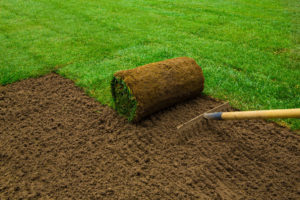
A lawn is a very important part of a home’s curb appeal. Revitalizing an existing lawn or developing new ones requires an important decision – should you seed it or sod it? No better time than the present to get your lawn in shape. Whether you inherited a less than perfect lawn or have built a new home and are starting with bare soil that is no better time than now to decide sod vs. seed. Here we will explore both sides, reviewing the benefits of sod lawns as well as reasons to seed your lawn.
Lawn Evaluation and Renovation
Carefully examine the lawn for weeds, undesirable grasses, and areas that are bare. If your lawn has less than 40% weeds, improving what you have is viable. If the Lawn has more than 40% weeds it is best to start from scratch and renovate. It may take a while but overseeding and eliminating weeds can turn marginal lawns into healthy lawns. On average grass seed takes approximately 7-14 days to germinate depending on the seed variety and then another 2-3 weeks to mature enough to start mowing just like your existing or old lawn. Sod conforms to the ground’s contours — you do not want any low-lying areas along the ground for standing water to accumulate. With proper soil preparation, sod roots can take hold in as little as two weeks. Another good idea is to test your soil it is a large part of any successful lawn project. Look into essentials such as soil pH, organic matter, and necessary nutrients. When your starting point is confirmed, you can fertilize and amend your soil and improve its ability to support healthy grass.
Sod vs Seed
What are the advantages and disadvantages?: Whether you establish your new lawn from sod or seed, all the personal and environmental benefits lawns offer can be yours. Both lead to healthy lawns but the methods differ a lot from the start. What is sod? To put it simply, sod is grass. It’s a grass that is grown and harvested for the specific purpose of transplantation. … When it’s ready for harvest, they take the grass along with a layer of soil entangled within the root system. It is sold in ruglike rolls ready to be unfurled and it comes with a unique set of pros and cons…
Sod Pros…
- Instant Results – it is not ready for traffic but it gives the look of a finished lawn
- Erosion Control – On slopes sod works as a blanket to hold soil in place as soon as it is laid down
- Fast establishment – New sod generally takes just two to three weeks to root with the proper installation
- Limited weeds – State-certified sod has few or no weeds
- Time of Year Versatility – Sod can be installed anytime in the growing season other than in extreme heat.
- Normal Lawn Traffic – Once sod roots establish it is ready for normal traffic including entertaining, and pets
Sod Cons…
- Cost – Sod has a high initial cost compared to grass seed coverage
- Few Grass Choices – It is up to the sod farmer’s choice.
- High Labor Expenses – Effective results may require trained professionals
- Growing Conditions – The conditions in your yard may be different than where the sod was grown. If the sod was grown in full sun and you have a shady yard could be difficult to take root.
- Short Transplanting Window – Sod must be laid preferably within 24 hours of being harvested.
Grass Seed Pros…
- Cost – Much less than the cost of sod
- Low Labor Costs – This can be a DIY event
- Many Grass Choices – Match your seed to your environmental desires. And your geographic location.
- Established in place – Seed continues to grow in the same place where they germinate and root.
Grass Seed Cons…
- Seeding Time Restrictions – To establish well, seed should be sown during peak growth times for the grass involved. Improper timing leads to failed seed.
- Initial Results – Gemination speeds vary between grasses, but newly seeded lawn may take up to 10 or12 weeks before the lawn is ready for activity.
- Maintenance – Watering is critical during seed establishment.
- Erosion – Seed and soil can wash away in heavy rain until roots establish
- Weeds – Grass seeds are vulnerable to competition from weed seeds for water, light, and nutrients.
- Longer Maturity Time – A newly seeded lawn needs one full year before it is mature and established.
Sod can be great, but it’s not always the best option, especially if you lack the budget. Beyond that, the seed will give you more options when choosing the specific type of grass you want in your yard. Once again, it comes down to asking yourself what’s most important to you regarding your lawn. If you want something quick, hardy, and easy, then choose sod. If you have the patience and the green thumb, then there’s nothing wrong with choosing seed. You can always turn to professionals when it comes to lawn maintenance. All types of individualized solutions for landscape renovation, lawn maintenance, and other services are available.
Contact us (859-640-0657) for a free consultation!
—

About Presentable Landscaping
Presentable Landscaping provides many landscaping services to our customers in Northern Kentucky and Greater Cincinnati.
